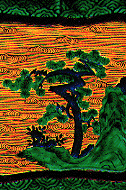Birthplace of Kutani
The ancestral home of Kutani ware is located in the Kutani district, near Yamanaka-machi, in Ishikawa prefecture. "Kutani" is taken from the late Edo period name of the area where it was originally produced, over 300 years ago. Presently this ware is divided into two styles; one -- the original, early period's ware, named "Ko-kutani"(literally "Old-Kutani"), and the other named "Restored Kutani", of more recent times. The cultural vigor of the late Edo period inspired the creation of many famous kilns, each of which strove to develop its own unique style; styles that have been passed down to the present. The first step in the creation of Kutani ware is an artisan's skillful shaping of the piece on the potter's wheel, which is followed by another artisan's skillful painting. In this way, a series of craftsmen painstakingly work to create finished pieces that reflect the original, dignified spirit of Kutani ware.Moving Ambiance Created with Five ColorsCraftsmen, who have mastered each of the painting styles, used to produce Kutani ware, such as Ko-Kutani Yoshida-ya and Aka-ei, can be seen painstakingly drawing hairlines on the unfired, white pieces. Next, these pieces are distempered with five colors (green, yellow, dark blue, purple, and red) which are then changed to enamel in the heat of the kiln. In the Meiji period, Shoza Kutani developed his own style which became popular for its painting of "Saishiki-kinrande" with all styles putting together and the works of his apprentices were exported to get a high position as industrial Arts of Kutani. |
||
 |
 |
|
| Ko-Kutani This style prospered under the guidance of Morikage Kusumi, expert of the Kano school of Japanese painting. It is characteristic of might and lovely design and flowing hair-line with five color paints (green ,Yellow, red, purple, and dark blue) |
Mokubei After the decline of the Ko-Kutani, the Kasugayama kiln was founded . Mokubei Aoki, painter in Kyoto is said to have led the style. Ground is generally painted red and figure of Chinese style is preferred as an object. |
|
 |
 |
 |
 |
| Yoshidaya This is a style of Ko-Kutani origin, painted all over with four colors except red with small pattern as ground, showing profound atmosphere. |
Iidaya (Aka-ei) This is a minute painting of figure with the color of red as ground and gold in places. |
Shoza This is the main style of today with all styles putting together. The "Saishiki-Kinrande" is characteristic of it. |
Eiraku This is a gorgeous style with red as ground and gold, showing refined beauty of "Kyo-yaki" style led by Wazen Eiraku. |
日本語版
Hello. Are you still able to comment on cups I have, if I send you a photo? Happy to donate to you.
ReplyDeleteThank you for this. I was looking for info on a tea set we have gotten in for auction, and this helped clear up the mystery a bit. Now I know Kutani is a style, not a manufacturer, and know the art style a bit more!
ReplyDelete